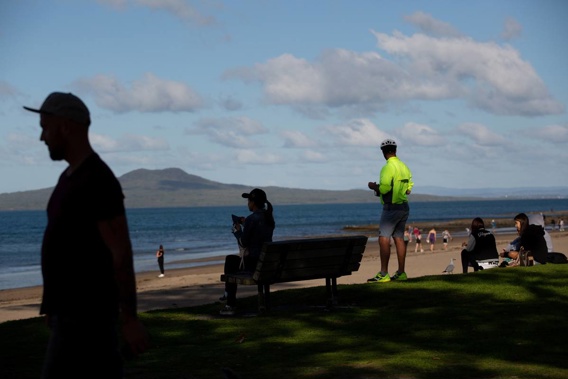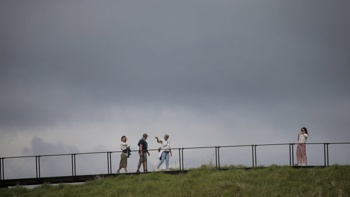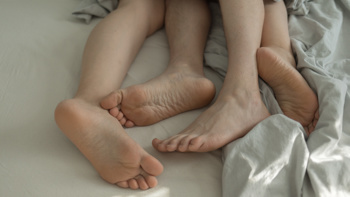
New Zealand could be moving down to level 2 as early as next Wednesday.
But how much more freedom will that give people?
Prime Minister Jacinda Ardern will reveal the exact details on Thursday but going to the gym, movies and restaurants already look set to be back on the cards, with some restrictions.
We spoke to a range of sector leaders to see what life at alert level 2 could, and should, look like and whether life will start returning to normal.
Travel and tourism
After more than a month of inactivity, the tourism industry is optimistic as most businesses will be able to reopen and domestic travel restrictions are expected to ease, even though the Government is yet to confirm anything.
Tourism Industry Aotearoa (TIA) said at this stage, level 2 does not allow non-essential domestic travel, but it was hoping that will change, saying New Zealanders who can travel safely must be allowed to do so.
TIA chief executive Chris Roberts said: "Safely reconnecting our families and communities is a social and economic necessity. Aviation, accommodation, hospitality, retail and most recreation and tourism activities can all be operated safely under level 2."
However, should that happen, travellers will have to get used to businesses having track and tracing processes.
"The level 2 guidelines specifically allow for activities like bungy jumping and kayaking
tours to resume, but there's little point opening your business if you can only have locals
as customers," Roberts said.
He said the next few months will be an amazing opportunity for Kiwis to experience the best New Zealand has to offer. That could start at alert level 2.
Simon Cheung, chair of the New Zealand Chinese Travel and Tourism Association, said most of its members were already gearing up for business.
"We have gone from marketing our services online to looking at advertising in local billboards because clearly our customer base has shifted from Chinese tourists to domestic travellers," Cheung said.
He said many were optimistic that the government will allow domestic travel "because it was the only sensible thing to do".
"For consumers, I believe pricing will be competitive and it will be the best time for Kiwis to re-discover our own backyard," Cheung said.
Recreation
Boaties get ready - recreational sports such as boating, fishing, hunting, mountain biking can all start up again under level 2.
Public venues such as museums, libraries, cinemas, gyms and pools can also re-open but may be run a bit differently.
Recreation Aotearoa spokesman Sam Newton said the facilities will have to ensure contact tracing and physical distancing and may have to limit the number of people entering the facilities at one time.
"At level 2 not a lot [of recreation] is disallowed. It's more of the stipulations around gatherings - no more than 100 inside or 500 outside."
Children should also be allowed to finally return to the local playgrounds.
Newton was hoping that inter-regional travel restrictions would also be lifted as this could be a barrier for some people to carry out certain sports.
For example someone in Auckland would have to travel outside the area to go white water rafting and someone in Queenstown would need to leave the area to surf, he said.
The skifields were also waiting on clarification around this as it would be a key factor as to whether they could open this season.
Uncertainty, however, remains about whether club sports and contact sports will resume.
Education
It's good news for parents struggling to work at home with their children - schools and early childhood educations centres will be open to all children at level 2.
Post Primary Teachers' Association president Jack Boyle, who represents secondary teachers, said he would expect the strict bubble restrictions of no more than 10 children under level 3 to be eased or lifted altogether.
"If there is an increased bubble or any type of bubble then that will have impacts on the staffing. I would imagine the direction of travel is towards not having bubbles or what was in the level 2 advice on the way up and that is gatherings of no more than 100."
He said some changes could include assemblies being cancelled to avoid mass gatherings. Larger schools with several thousand students may look to stagger intervals and how students enter the schools.
He also expected provisions to be made to support students who might be anxious about returning to school after prolonged separation from their peers and wanted it included in the timetable.
Vulnerable staff would also be encouraged to stay home and those who felt they needed to wear PPE gear would be allowed.
Increased sanitisation and hygiene practices would be in place and children who were feeling unwell would be expected to stay home.
Tertiary providers such as universities and polytechs can also open their doors again under level 2 but lectures or gatherings with more than 100 people cannot happen.
Most onsite activities were allowed as long as physical distancing requirements of 1 metre between students were met and contact tracing was in place.
Vulnerable staff and students should not be asked to attend and remote learning should be in place for them. Student halls could also re-open.
Universities New Zealand chief executive Chris Whelan said it was up to each university to decide when it would open its campuses —and how that would happen—depending on the needs of its own community and the physical requirements of the campus.
Businesses
Most businesses can open under level 2, but many will have to adopt a new model of operating.
Remote working, shift-based working, physical distancing, staggering meal breaks and flexible leave should be enforced to promote physical distancing.
Auckland Chamber of Commerce chief executive Michael Barnett said it would be a return to the "new normal" for many businesses.
"I think most businesses will open but I still think that many people will be working from home as offices work out what the social fairness is going to be."
Businesses would also need to ensure contact tracing and policies around staff being sick.
Manufacturers would also be back at work, but Barnett thought the demand for products could be less so they would have to quickly adjust their workforce.
Retailers will also be opening their doors again - but limits are likely over how many people can be in a store at one time.
Retail NZ chief executive Greg Harford said there had been very little difference for retailers between level 3 and 4 with sales being similar.
Harford expected stores would reopen, but it was likely physical distancing markers would be in place and perspex screens would be installed at the counter to separate staff. Staff were also likely to start wearing gloves.
He did not expect contact tracing would be needed at retail stores, given this was not required by supermarkets at level 2.
"This in-store experience is going to be different. There will be distancing requirements. There will be maximum numbers of people who will be allowed in any one store.
"The experience will be different for customers because people will need to move more slowly and maintain more spacing, so there could be queues to get into stores."
Click and collect offers could tail off slightly when customers were allowed back in stores, he said.
Small Business Voice chief executive Max Whitehead said it was crucial that all businesses could be open and operating under level 2.
"I think the general rule of two metres apart per person is reasonable and they would except that. But don't restrict them any more and enable them to make judgment calls in terms of what they are required to do."
Some staff would continue to work from home and employers should have the freedom to call people to work if necessary.
Supermarkets and hospitality
Supermarkets have been open right the pandemic and it doesn't appear there will be many changes from level 3 to 2 as physical distancing and mass gathering rules continue to be a priority.
Countdown and Foodstuffs were waiting on the guidance from the government before sharing if any changes would be made.
Countdown general manager of health and safety Kiri Hannifin said the safety processes in place for level 4 remained unchanged at level 3 and stores were still limiting the number of customers in stores at one time and ensure physical distancing.
Foodstuffs NZ head of corporate affairs Antoinette Laird said its stores, which include New World and Pak'n'Save, were planning ahead so they could respond quickly.
New Zealand Food and Grocery Council chief executive Katherine Rich said under level 2 it would start to become clear how many restaurants and cafes would not be reopening and this would give the food industry a better idea about how much it would lose in terms of revenue and jobs.
"Whether we are level 2 or 1 is not the focus. The journey that food and beverage companies are now on to repair, rebuild and grow will take at least a year."
Although it is unclear what dining out will be like at level 2, it is likely that diners will be socially distanced and asked to write down names and contact details at bars and restaurants.
The official alert level 2 guidelines state: "All gatherings must record attendees to ensure contact tracing may be conducted if necessary."
The Restaurant Association says it is finalising level 2 guidelines and working with WorkSafe and MBIE.
"Cabinet has yet to announce what level 2 will look like in detail but we are involved in writing the guidelines. From what we understand at this stage it will look similar to the previous alert level 2," said association chief executive Marisa Bidois.
This would include reopening shop fronts to allow people to dine in but at a 2m distance from other diners.
"This would mean fewer tables to allow for adequate space between diners," she said.
"We also expect there to be logs of all diners. At the moment we don't know whether the restaurants themselves will be required to keep contact-tracing information or whether this will come in the form of a contact-tracing app from government."
Bidois said that even though restaurants had been allowed to open for takeaways at level 3, it has not been a silver bullet.
"Most businesses have not been able to fully adapt their offer to takeaway only and it's only once we can return to dining in that we will see revenues rise for many," she said.
"That having been said, consumer confidence may still be low and with no tourism, we still expect to see at least a 20 per cent fall out."
She said it would be a challenge for restaurants to make sure self-distancing and contact tracing worked.
Reduced room for dining tables and the extra spacing required would continue to put financial pressure on our sector.
Real estate
House sales reached record lows at the end of March and April, and the industry is ready for the restrictions to lift.
Open homes are expected to be reinstated and real estate agents should be able to take more people through properties and attend on-site appraisals as long as they maintain physical distancing.
Real estate offices will also reopen.
The Real Estate Authority was still developing official guidance around level 2, but it is likely that open homes may be able to go ahead with some restrictions.
Agents already collect details of people viewing properties at open home so contact tracing was already in place.
REA chief executive Kevin Lampen-Smith said the guidance would be consistent with government guidance for alert level 2, which states that gatherings of up to 100 people indoors will be allowed while maintaining physical distancing and contact tracing requirements.
Police and courts
Police enforce the various levels of restriction set by the government and will continue to do so under level 2 using an education-first approach.
"Enforcement options are available for serious or persistent breaches, however, the specific nature of the alert level 2 guidelines is not yet known," a police spokesperson said.
"And even after the official rules are laid out, police officers will have to use discretion to enforce them."
With strict restrictions around on mass gatherings of no more than 100 allowed to take place, this could be a likely focus.
Meanwhile courts will slowly start getting back to normal with level 2 allowing more cases to be heard - with the exception of criminal jury trials, which will not start before August 3.
The District Court is hearing all bail applications, case reviews and pleas, and basic sentencing is going ahead.
The High Court is hearing custodial remands, criminal appeals, pre-trial applications and low-profile sentencing.
The precise details of what level 2 might mean for the different jurisdictions and court houses is still unknown, but a Courts spokesperson said it was likely to lead to an expansion of the work.
Health
Health and disability care services should be able to operate normally where possible.
Like level 3 and 4, primary care consultations should be done over the phone or via video call if possible.
Urgent and semi-urgent elective surgeries resumed under level 3 and more of these, including non-acute cases, are likely to be carried out at both private and public hospitals.
There may also be a further relaxing of rules in regards to visitors to hospitals. Under alert level 3, patients were allowed one visitor a day.
and
Take your Radio, Podcasts and Music with you









